Darlington Upgrade Project PDF
VerifiedAdded on 2021/09/10
|14
|3379
|84
AI Summary
Contribute Materials
Your contribution can guide someone’s learning journey. Share your
documents today.

Mid Project Review 1
MID PROJECT REVIEW
By Name
Course
Instructor
Institution
Location
Date
MID PROJECT REVIEW
By Name
Course
Instructor
Institution
Location
Date
Secure Best Marks with AI Grader
Need help grading? Try our AI Grader for instant feedback on your assignments.
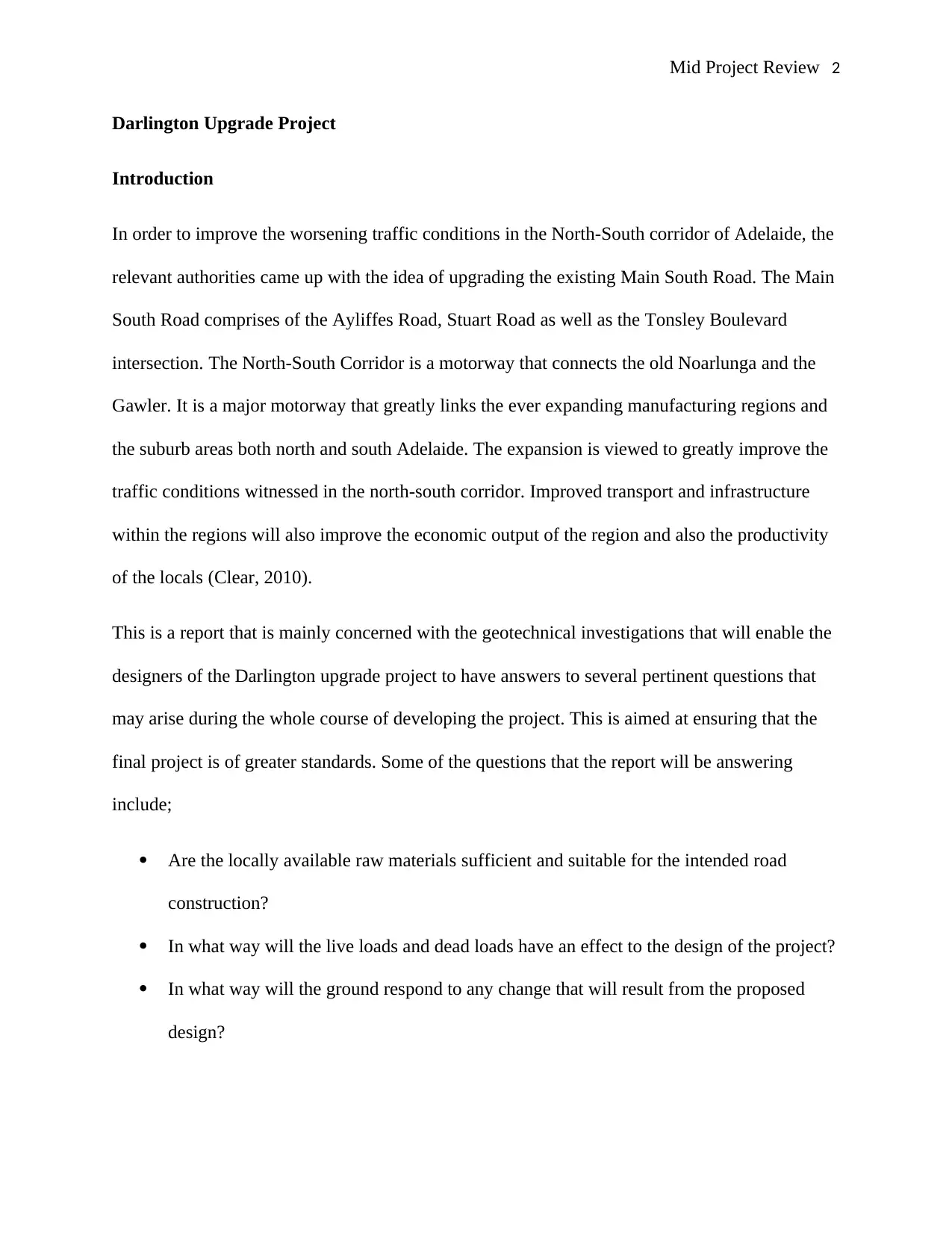
Mid Project Review 2
Darlington Upgrade Project
Introduction
In order to improve the worsening traffic conditions in the North-South corridor of Adelaide, the
relevant authorities came up with the idea of upgrading the existing Main South Road. The Main
South Road comprises of the Ayliffes Road, Stuart Road as well as the Tonsley Boulevard
intersection. The North-South Corridor is a motorway that connects the old Noarlunga and the
Gawler. It is a major motorway that greatly links the ever expanding manufacturing regions and
the suburb areas both north and south Adelaide. The expansion is viewed to greatly improve the
traffic conditions witnessed in the north-south corridor. Improved transport and infrastructure
within the regions will also improve the economic output of the region and also the productivity
of the locals (Clear, 2010).
This is a report that is mainly concerned with the geotechnical investigations that will enable the
designers of the Darlington upgrade project to have answers to several pertinent questions that
may arise during the whole course of developing the project. This is aimed at ensuring that the
final project is of greater standards. Some of the questions that the report will be answering
include;
Are the locally available raw materials sufficient and suitable for the intended road
construction?
In what way will the live loads and dead loads have an effect to the design of the project?
In what way will the ground respond to any change that will result from the proposed
design?
Darlington Upgrade Project
Introduction
In order to improve the worsening traffic conditions in the North-South corridor of Adelaide, the
relevant authorities came up with the idea of upgrading the existing Main South Road. The Main
South Road comprises of the Ayliffes Road, Stuart Road as well as the Tonsley Boulevard
intersection. The North-South Corridor is a motorway that connects the old Noarlunga and the
Gawler. It is a major motorway that greatly links the ever expanding manufacturing regions and
the suburb areas both north and south Adelaide. The expansion is viewed to greatly improve the
traffic conditions witnessed in the north-south corridor. Improved transport and infrastructure
within the regions will also improve the economic output of the region and also the productivity
of the locals (Clear, 2010).
This is a report that is mainly concerned with the geotechnical investigations that will enable the
designers of the Darlington upgrade project to have answers to several pertinent questions that
may arise during the whole course of developing the project. This is aimed at ensuring that the
final project is of greater standards. Some of the questions that the report will be answering
include;
Are the locally available raw materials sufficient and suitable for the intended road
construction?
In what way will the live loads and dead loads have an effect to the design of the project?
In what way will the ground respond to any change that will result from the proposed
design?
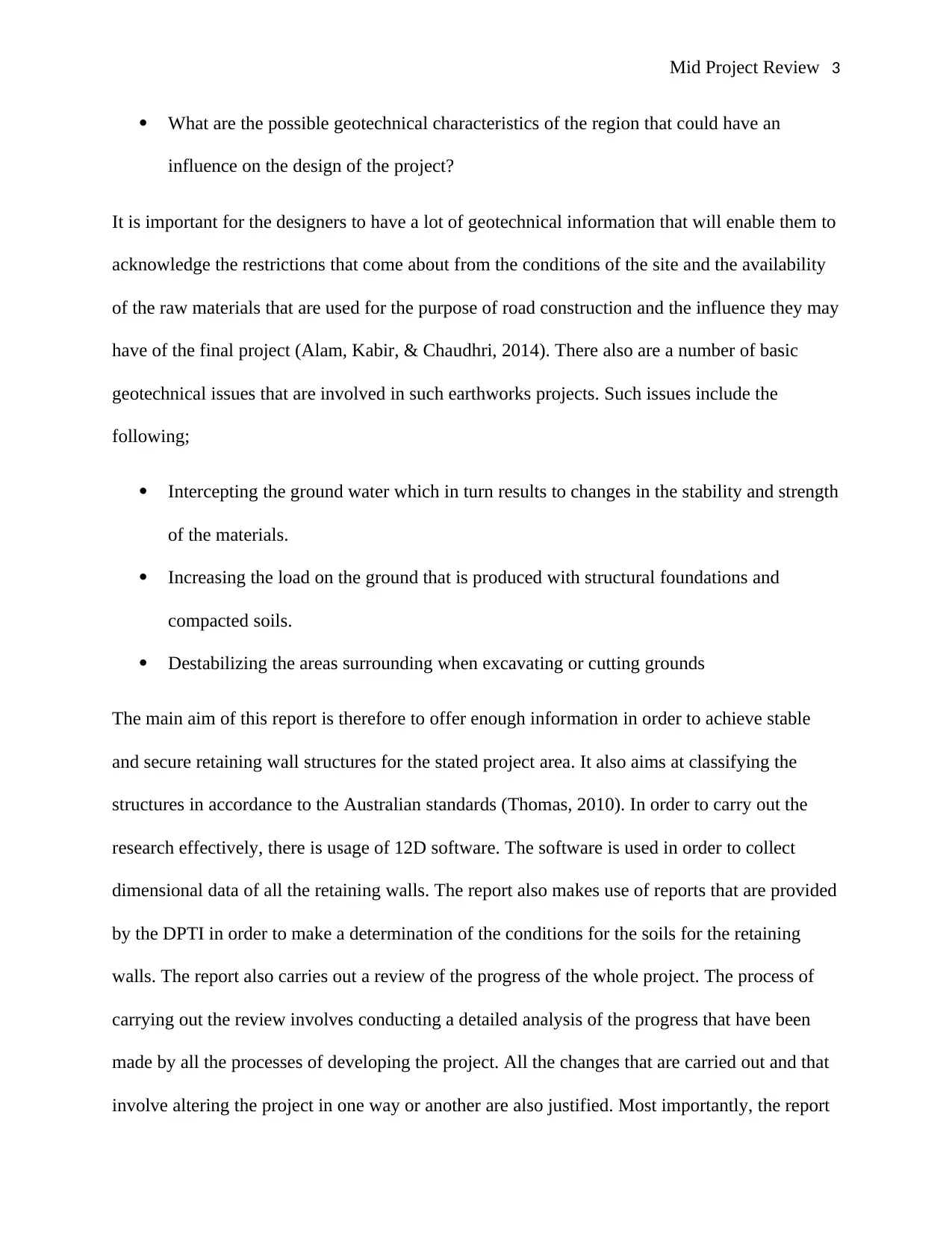
Mid Project Review 3
What are the possible geotechnical characteristics of the region that could have an
influence on the design of the project?
It is important for the designers to have a lot of geotechnical information that will enable them to
acknowledge the restrictions that come about from the conditions of the site and the availability
of the raw materials that are used for the purpose of road construction and the influence they may
have of the final project (Alam, Kabir, & Chaudhri, 2014). There also are a number of basic
geotechnical issues that are involved in such earthworks projects. Such issues include the
following;
Intercepting the ground water which in turn results to changes in the stability and strength
of the materials.
Increasing the load on the ground that is produced with structural foundations and
compacted soils.
Destabilizing the areas surrounding when excavating or cutting grounds
The main aim of this report is therefore to offer enough information in order to achieve stable
and secure retaining wall structures for the stated project area. It also aims at classifying the
structures in accordance to the Australian standards (Thomas, 2010). In order to carry out the
research effectively, there is usage of 12D software. The software is used in order to collect
dimensional data of all the retaining walls. The report also makes use of reports that are provided
by the DPTI in order to make a determination of the conditions for the soils for the retaining
walls. The report also carries out a review of the progress of the whole project. The process of
carrying out the review involves conducting a detailed analysis of the progress that have been
made by all the processes of developing the project. All the changes that are carried out and that
involve altering the project in one way or another are also justified. Most importantly, the report
What are the possible geotechnical characteristics of the region that could have an
influence on the design of the project?
It is important for the designers to have a lot of geotechnical information that will enable them to
acknowledge the restrictions that come about from the conditions of the site and the availability
of the raw materials that are used for the purpose of road construction and the influence they may
have of the final project (Alam, Kabir, & Chaudhri, 2014). There also are a number of basic
geotechnical issues that are involved in such earthworks projects. Such issues include the
following;
Intercepting the ground water which in turn results to changes in the stability and strength
of the materials.
Increasing the load on the ground that is produced with structural foundations and
compacted soils.
Destabilizing the areas surrounding when excavating or cutting grounds
The main aim of this report is therefore to offer enough information in order to achieve stable
and secure retaining wall structures for the stated project area. It also aims at classifying the
structures in accordance to the Australian standards (Thomas, 2010). In order to carry out the
research effectively, there is usage of 12D software. The software is used in order to collect
dimensional data of all the retaining walls. The report also makes use of reports that are provided
by the DPTI in order to make a determination of the conditions for the soils for the retaining
walls. The report also carries out a review of the progress of the whole project. The process of
carrying out the review involves conducting a detailed analysis of the progress that have been
made by all the processes of developing the project. All the changes that are carried out and that
involve altering the project in one way or another are also justified. Most importantly, the report
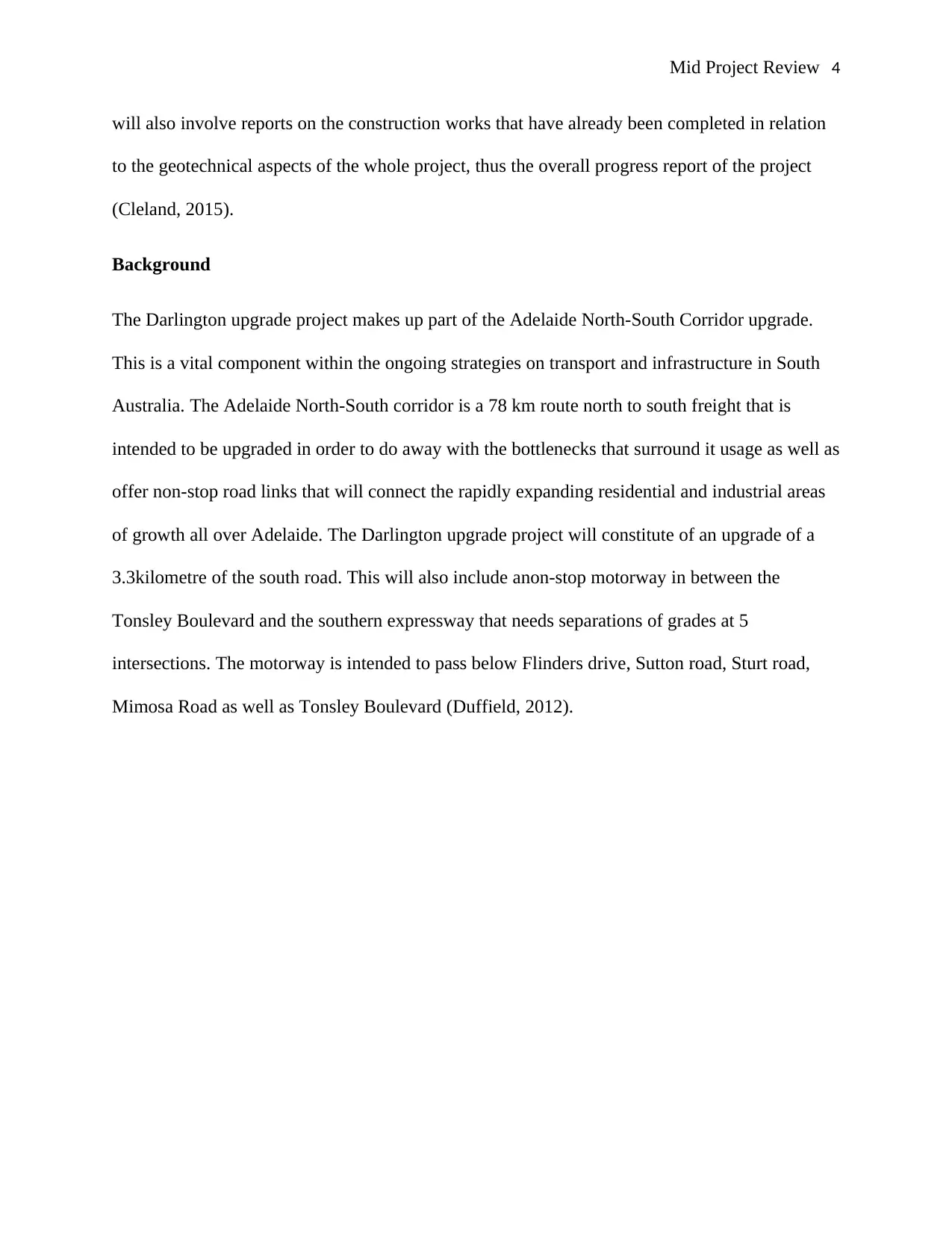
Mid Project Review 4
will also involve reports on the construction works that have already been completed in relation
to the geotechnical aspects of the whole project, thus the overall progress report of the project
(Cleland, 2015).
Background
The Darlington upgrade project makes up part of the Adelaide North-South Corridor upgrade.
This is a vital component within the ongoing strategies on transport and infrastructure in South
Australia. The Adelaide North-South corridor is a 78 km route north to south freight that is
intended to be upgraded in order to do away with the bottlenecks that surround it usage as well as
offer non-stop road links that will connect the rapidly expanding residential and industrial areas
of growth all over Adelaide. The Darlington upgrade project will constitute of an upgrade of a
3.3kilometre of the south road. This will also include anon-stop motorway in between the
Tonsley Boulevard and the southern expressway that needs separations of grades at 5
intersections. The motorway is intended to pass below Flinders drive, Sutton road, Sturt road,
Mimosa Road as well as Tonsley Boulevard (Duffield, 2012).
will also involve reports on the construction works that have already been completed in relation
to the geotechnical aspects of the whole project, thus the overall progress report of the project
(Cleland, 2015).
Background
The Darlington upgrade project makes up part of the Adelaide North-South Corridor upgrade.
This is a vital component within the ongoing strategies on transport and infrastructure in South
Australia. The Adelaide North-South corridor is a 78 km route north to south freight that is
intended to be upgraded in order to do away with the bottlenecks that surround it usage as well as
offer non-stop road links that will connect the rapidly expanding residential and industrial areas
of growth all over Adelaide. The Darlington upgrade project will constitute of an upgrade of a
3.3kilometre of the south road. This will also include anon-stop motorway in between the
Tonsley Boulevard and the southern expressway that needs separations of grades at 5
intersections. The motorway is intended to pass below Flinders drive, Sutton road, Sturt road,
Mimosa Road as well as Tonsley Boulevard (Duffield, 2012).
Secure Best Marks with AI Grader
Need help grading? Try our AI Grader for instant feedback on your assignments.
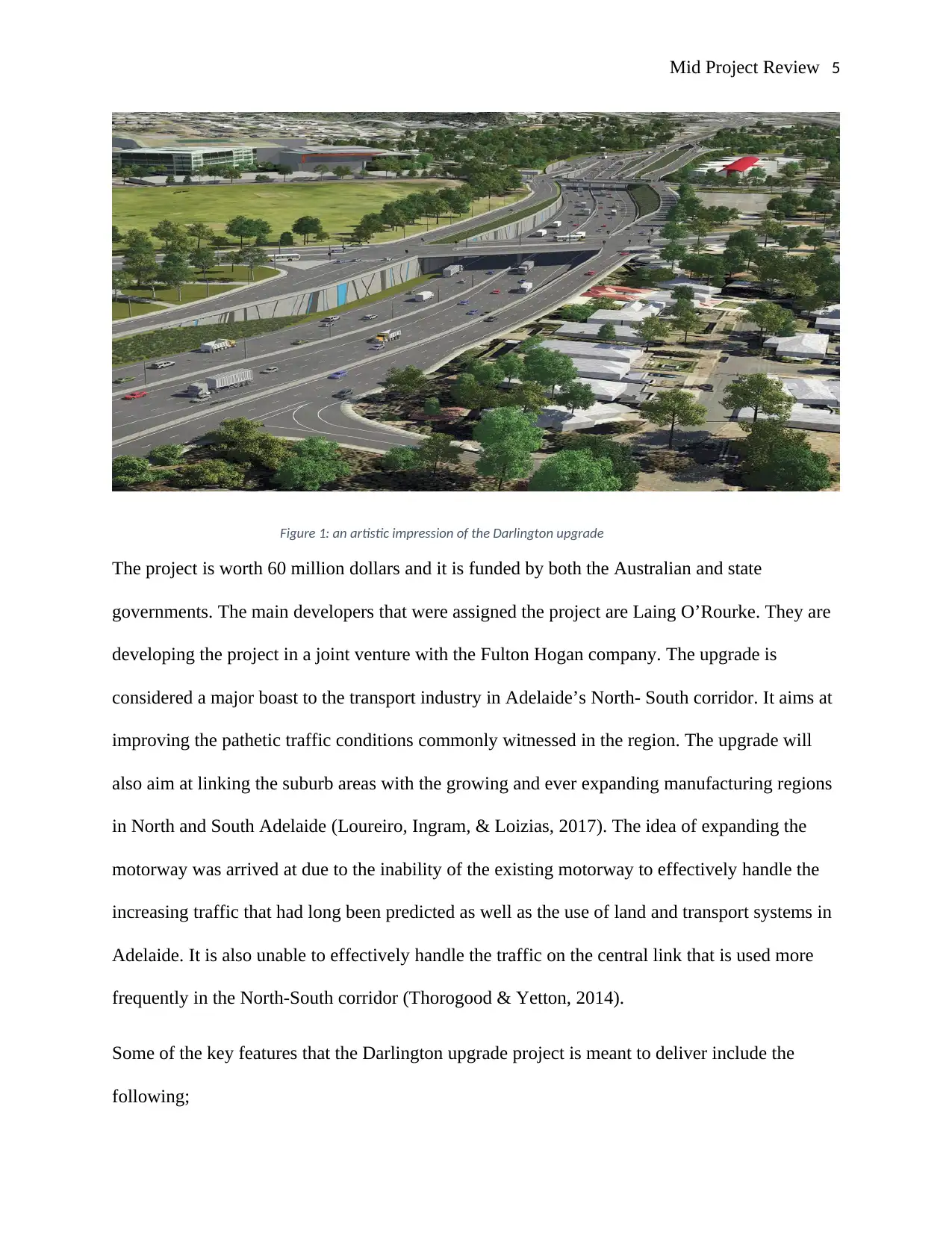
Mid Project Review 5
Figure 1: an artistic impression of the Darlington upgrade
The project is worth 60 million dollars and it is funded by both the Australian and state
governments. The main developers that were assigned the project are Laing O’Rourke. They are
developing the project in a joint venture with the Fulton Hogan company. The upgrade is
considered a major boast to the transport industry in Adelaide’s North- South corridor. It aims at
improving the pathetic traffic conditions commonly witnessed in the region. The upgrade will
also aim at linking the suburb areas with the growing and ever expanding manufacturing regions
in North and South Adelaide (Loureiro, Ingram, & Loizias, 2017). The idea of expanding the
motorway was arrived at due to the inability of the existing motorway to effectively handle the
increasing traffic that had long been predicted as well as the use of land and transport systems in
Adelaide. It is also unable to effectively handle the traffic on the central link that is used more
frequently in the North-South corridor (Thorogood & Yetton, 2014).
Some of the key features that the Darlington upgrade project is meant to deliver include the
following;
Figure 1: an artistic impression of the Darlington upgrade
The project is worth 60 million dollars and it is funded by both the Australian and state
governments. The main developers that were assigned the project are Laing O’Rourke. They are
developing the project in a joint venture with the Fulton Hogan company. The upgrade is
considered a major boast to the transport industry in Adelaide’s North- South corridor. It aims at
improving the pathetic traffic conditions commonly witnessed in the region. The upgrade will
also aim at linking the suburb areas with the growing and ever expanding manufacturing regions
in North and South Adelaide (Loureiro, Ingram, & Loizias, 2017). The idea of expanding the
motorway was arrived at due to the inability of the existing motorway to effectively handle the
increasing traffic that had long been predicted as well as the use of land and transport systems in
Adelaide. It is also unable to effectively handle the traffic on the central link that is used more
frequently in the North-South corridor (Thorogood & Yetton, 2014).
Some of the key features that the Darlington upgrade project is meant to deliver include the
following;
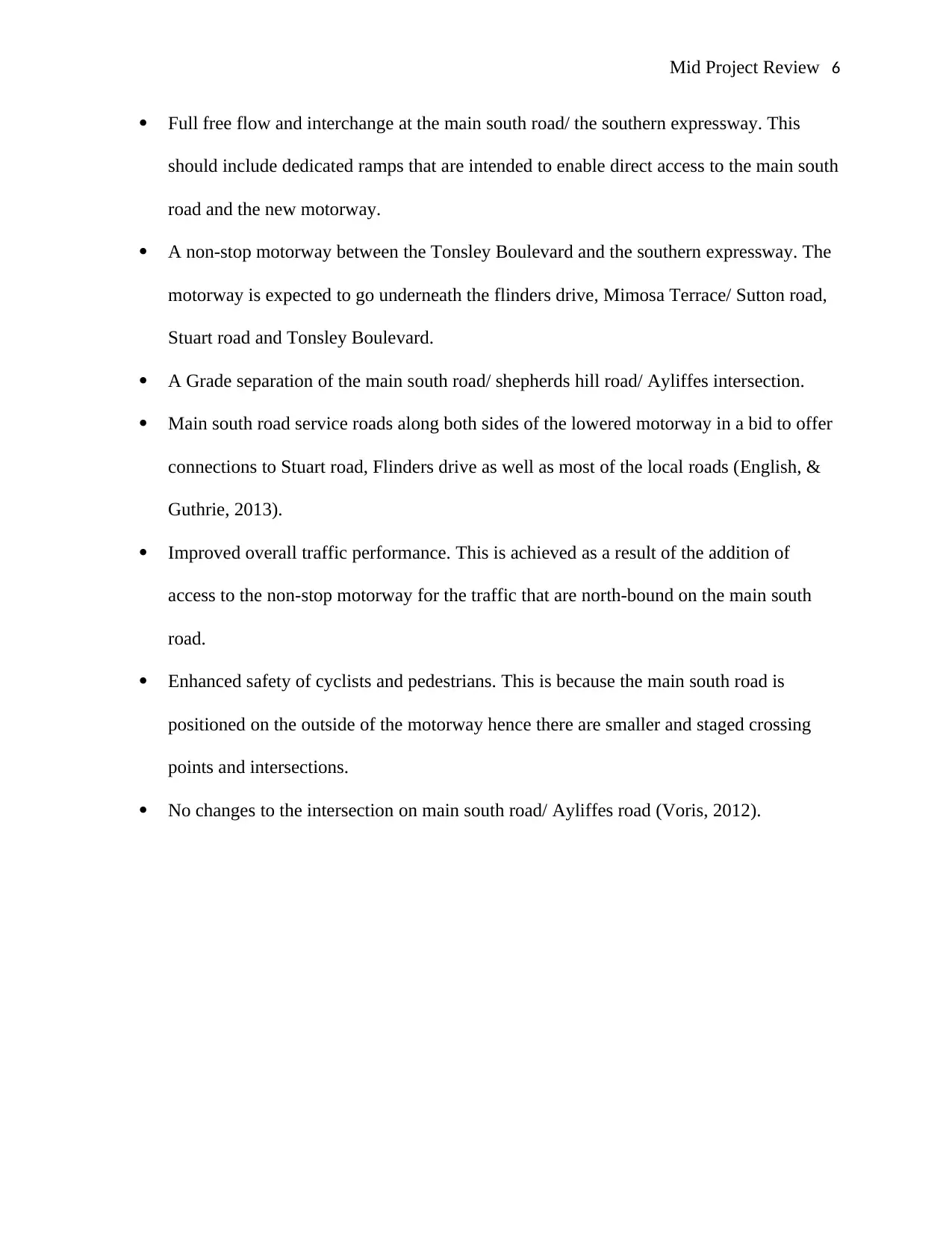
Mid Project Review 6
Full free flow and interchange at the main south road/ the southern expressway. This
should include dedicated ramps that are intended to enable direct access to the main south
road and the new motorway.
A non-stop motorway between the Tonsley Boulevard and the southern expressway. The
motorway is expected to go underneath the flinders drive, Mimosa Terrace/ Sutton road,
Stuart road and Tonsley Boulevard.
A Grade separation of the main south road/ shepherds hill road/ Ayliffes intersection.
Main south road service roads along both sides of the lowered motorway in a bid to offer
connections to Stuart road, Flinders drive as well as most of the local roads (English, &
Guthrie, 2013).
Improved overall traffic performance. This is achieved as a result of the addition of
access to the non-stop motorway for the traffic that are north-bound on the main south
road.
Enhanced safety of cyclists and pedestrians. This is because the main south road is
positioned on the outside of the motorway hence there are smaller and staged crossing
points and intersections.
No changes to the intersection on main south road/ Ayliffes road (Voris, 2012).
Full free flow and interchange at the main south road/ the southern expressway. This
should include dedicated ramps that are intended to enable direct access to the main south
road and the new motorway.
A non-stop motorway between the Tonsley Boulevard and the southern expressway. The
motorway is expected to go underneath the flinders drive, Mimosa Terrace/ Sutton road,
Stuart road and Tonsley Boulevard.
A Grade separation of the main south road/ shepherds hill road/ Ayliffes intersection.
Main south road service roads along both sides of the lowered motorway in a bid to offer
connections to Stuart road, Flinders drive as well as most of the local roads (English, &
Guthrie, 2013).
Improved overall traffic performance. This is achieved as a result of the addition of
access to the non-stop motorway for the traffic that are north-bound on the main south
road.
Enhanced safety of cyclists and pedestrians. This is because the main south road is
positioned on the outside of the motorway hence there are smaller and staged crossing
points and intersections.
No changes to the intersection on main south road/ Ayliffes road (Voris, 2012).
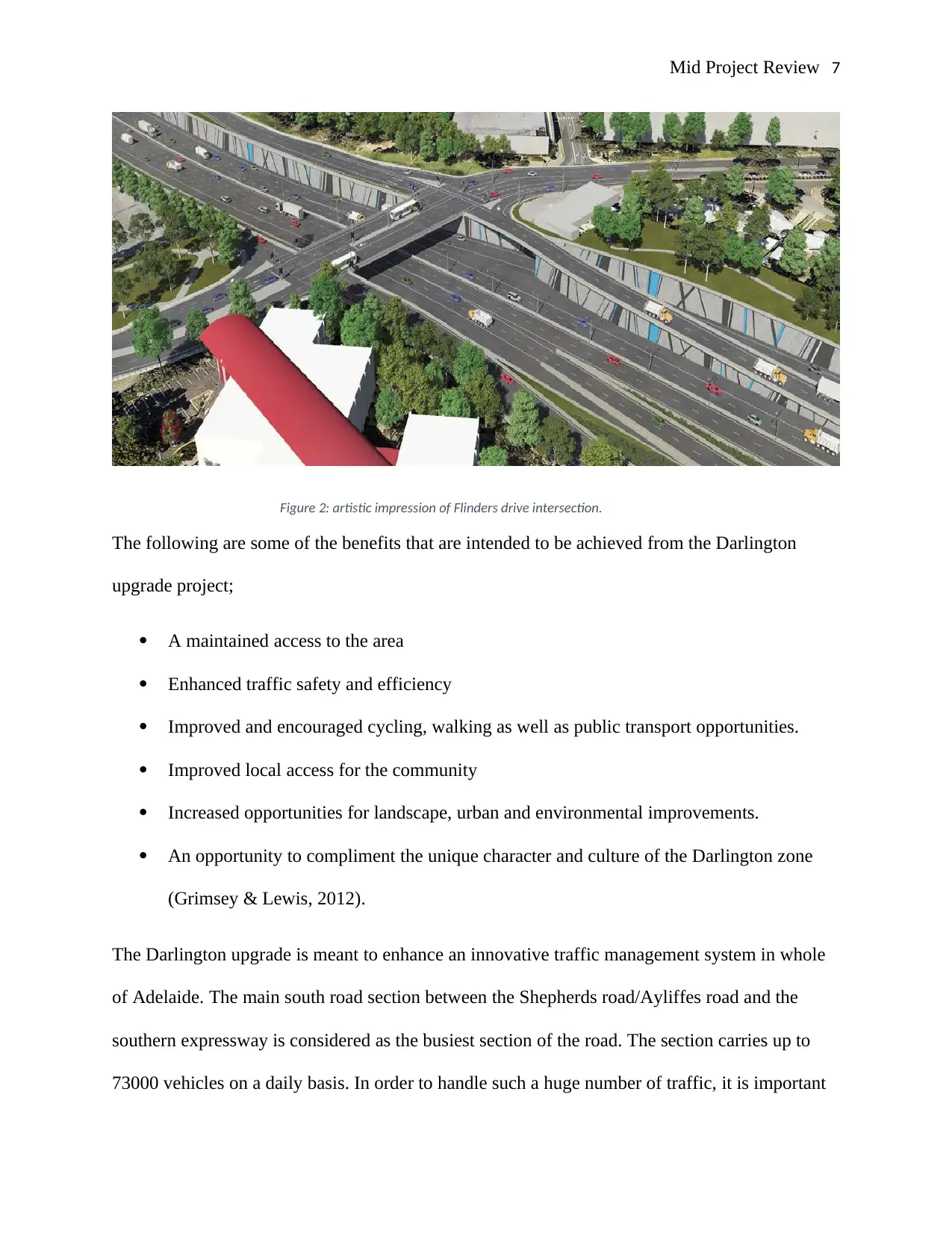
Mid Project Review 7
Figure 2: artistic impression of Flinders drive intersection.
The following are some of the benefits that are intended to be achieved from the Darlington
upgrade project;
A maintained access to the area
Enhanced traffic safety and efficiency
Improved and encouraged cycling, walking as well as public transport opportunities.
Improved local access for the community
Increased opportunities for landscape, urban and environmental improvements.
An opportunity to compliment the unique character and culture of the Darlington zone
(Grimsey & Lewis, 2012).
The Darlington upgrade is meant to enhance an innovative traffic management system in whole
of Adelaide. The main south road section between the Shepherds road/Ayliffes road and the
southern expressway is considered as the busiest section of the road. The section carries up to
73000 vehicles on a daily basis. In order to handle such a huge number of traffic, it is important
Figure 2: artistic impression of Flinders drive intersection.
The following are some of the benefits that are intended to be achieved from the Darlington
upgrade project;
A maintained access to the area
Enhanced traffic safety and efficiency
Improved and encouraged cycling, walking as well as public transport opportunities.
Improved local access for the community
Increased opportunities for landscape, urban and environmental improvements.
An opportunity to compliment the unique character and culture of the Darlington zone
(Grimsey & Lewis, 2012).
The Darlington upgrade is meant to enhance an innovative traffic management system in whole
of Adelaide. The main south road section between the Shepherds road/Ayliffes road and the
southern expressway is considered as the busiest section of the road. The section carries up to
73000 vehicles on a daily basis. In order to handle such a huge number of traffic, it is important
Paraphrase This Document
Need a fresh take? Get an instant paraphrase of this document with our AI Paraphraser
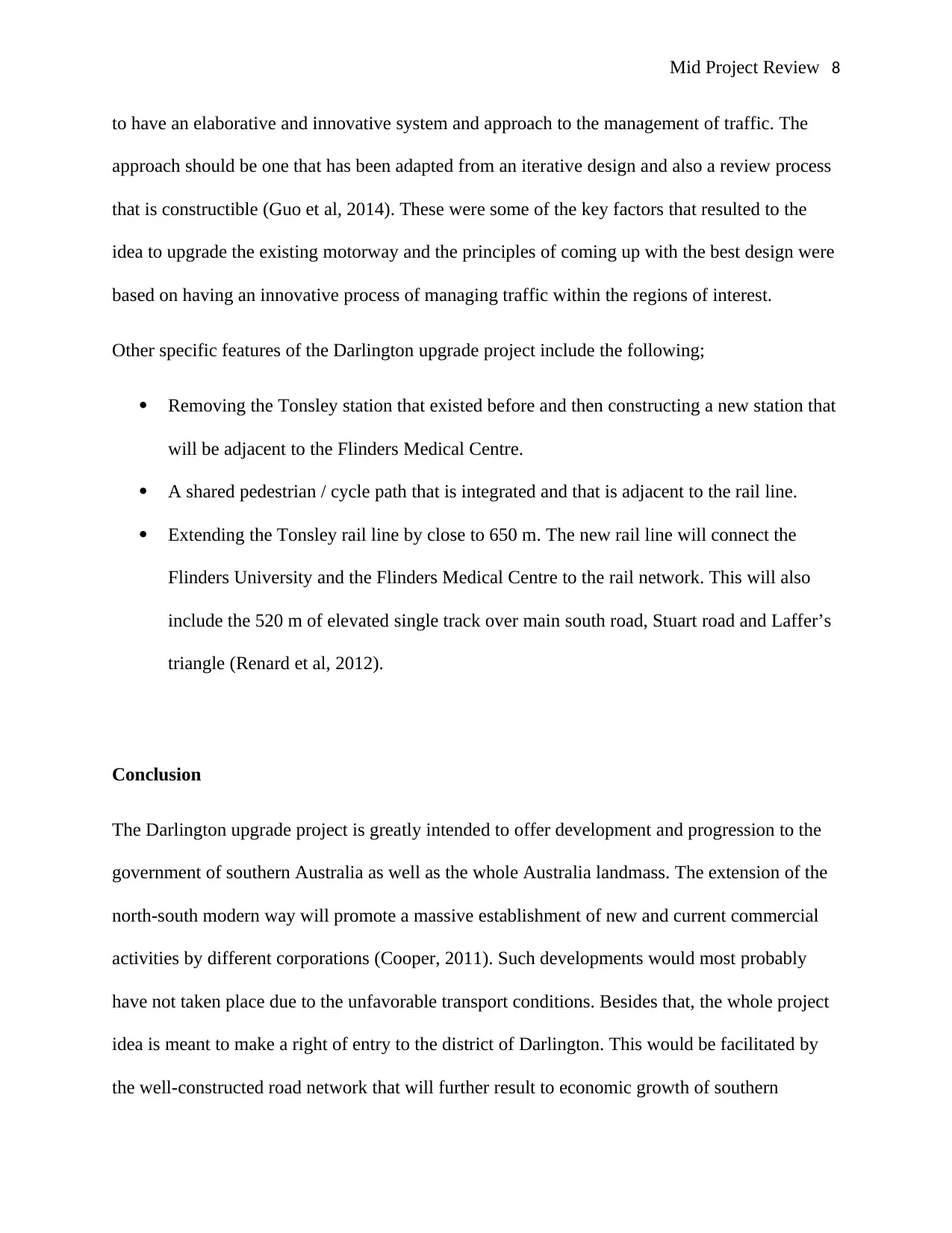
Mid Project Review 8
to have an elaborative and innovative system and approach to the management of traffic. The
approach should be one that has been adapted from an iterative design and also a review process
that is constructible (Guo et al, 2014). These were some of the key factors that resulted to the
idea to upgrade the existing motorway and the principles of coming up with the best design were
based on having an innovative process of managing traffic within the regions of interest.
Other specific features of the Darlington upgrade project include the following;
Removing the Tonsley station that existed before and then constructing a new station that
will be adjacent to the Flinders Medical Centre.
A shared pedestrian / cycle path that is integrated and that is adjacent to the rail line.
Extending the Tonsley rail line by close to 650 m. The new rail line will connect the
Flinders University and the Flinders Medical Centre to the rail network. This will also
include the 520 m of elevated single track over main south road, Stuart road and Laffer’s
triangle (Renard et al, 2012).
Conclusion
The Darlington upgrade project is greatly intended to offer development and progression to the
government of southern Australia as well as the whole Australia landmass. The extension of the
north-south modern way will promote a massive establishment of new and current commercial
activities by different corporations (Cooper, 2011). Such developments would most probably
have not taken place due to the unfavorable transport conditions. Besides that, the whole project
idea is meant to make a right of entry to the district of Darlington. This would be facilitated by
the well-constructed road network that will further result to economic growth of southern
to have an elaborative and innovative system and approach to the management of traffic. The
approach should be one that has been adapted from an iterative design and also a review process
that is constructible (Guo et al, 2014). These were some of the key factors that resulted to the
idea to upgrade the existing motorway and the principles of coming up with the best design were
based on having an innovative process of managing traffic within the regions of interest.
Other specific features of the Darlington upgrade project include the following;
Removing the Tonsley station that existed before and then constructing a new station that
will be adjacent to the Flinders Medical Centre.
A shared pedestrian / cycle path that is integrated and that is adjacent to the rail line.
Extending the Tonsley rail line by close to 650 m. The new rail line will connect the
Flinders University and the Flinders Medical Centre to the rail network. This will also
include the 520 m of elevated single track over main south road, Stuart road and Laffer’s
triangle (Renard et al, 2012).
Conclusion
The Darlington upgrade project is greatly intended to offer development and progression to the
government of southern Australia as well as the whole Australia landmass. The extension of the
north-south modern way will promote a massive establishment of new and current commercial
activities by different corporations (Cooper, 2011). Such developments would most probably
have not taken place due to the unfavorable transport conditions. Besides that, the whole project
idea is meant to make a right of entry to the district of Darlington. This would be facilitated by
the well-constructed road network that will further result to economic growth of southern
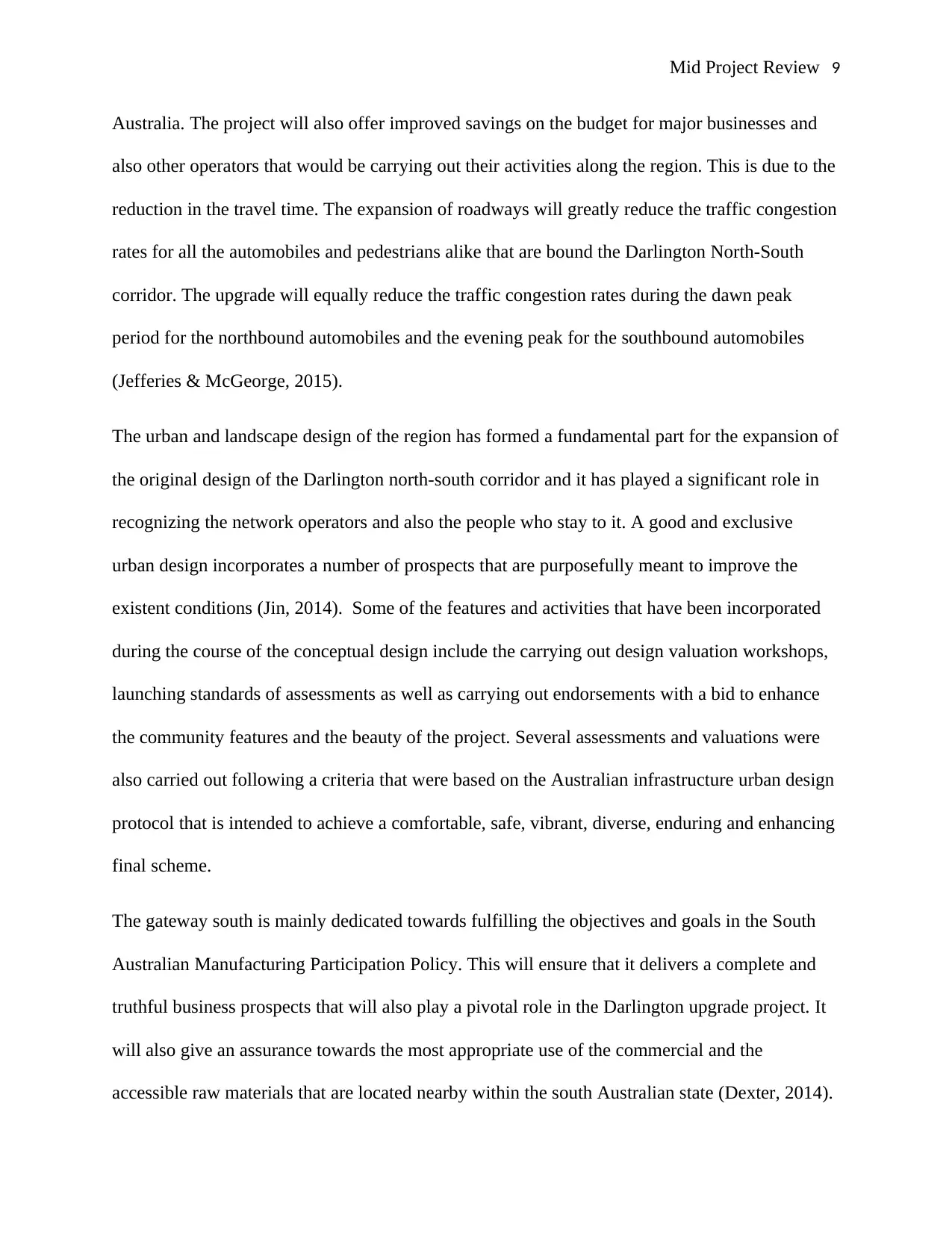
Mid Project Review 9
Australia. The project will also offer improved savings on the budget for major businesses and
also other operators that would be carrying out their activities along the region. This is due to the
reduction in the travel time. The expansion of roadways will greatly reduce the traffic congestion
rates for all the automobiles and pedestrians alike that are bound the Darlington North-South
corridor. The upgrade will equally reduce the traffic congestion rates during the dawn peak
period for the northbound automobiles and the evening peak for the southbound automobiles
(Jefferies & McGeorge, 2015).
The urban and landscape design of the region has formed a fundamental part for the expansion of
the original design of the Darlington north-south corridor and it has played a significant role in
recognizing the network operators and also the people who stay to it. A good and exclusive
urban design incorporates a number of prospects that are purposefully meant to improve the
existent conditions (Jin, 2014). Some of the features and activities that have been incorporated
during the course of the conceptual design include the carrying out design valuation workshops,
launching standards of assessments as well as carrying out endorsements with a bid to enhance
the community features and the beauty of the project. Several assessments and valuations were
also carried out following a criteria that were based on the Australian infrastructure urban design
protocol that is intended to achieve a comfortable, safe, vibrant, diverse, enduring and enhancing
final scheme.
The gateway south is mainly dedicated towards fulfilling the objectives and goals in the South
Australian Manufacturing Participation Policy. This will ensure that it delivers a complete and
truthful business prospects that will also play a pivotal role in the Darlington upgrade project. It
will also give an assurance towards the most appropriate use of the commercial and the
accessible raw materials that are located nearby within the south Australian state (Dexter, 2014).
Australia. The project will also offer improved savings on the budget for major businesses and
also other operators that would be carrying out their activities along the region. This is due to the
reduction in the travel time. The expansion of roadways will greatly reduce the traffic congestion
rates for all the automobiles and pedestrians alike that are bound the Darlington North-South
corridor. The upgrade will equally reduce the traffic congestion rates during the dawn peak
period for the northbound automobiles and the evening peak for the southbound automobiles
(Jefferies & McGeorge, 2015).
The urban and landscape design of the region has formed a fundamental part for the expansion of
the original design of the Darlington north-south corridor and it has played a significant role in
recognizing the network operators and also the people who stay to it. A good and exclusive
urban design incorporates a number of prospects that are purposefully meant to improve the
existent conditions (Jin, 2014). Some of the features and activities that have been incorporated
during the course of the conceptual design include the carrying out design valuation workshops,
launching standards of assessments as well as carrying out endorsements with a bid to enhance
the community features and the beauty of the project. Several assessments and valuations were
also carried out following a criteria that were based on the Australian infrastructure urban design
protocol that is intended to achieve a comfortable, safe, vibrant, diverse, enduring and enhancing
final scheme.
The gateway south is mainly dedicated towards fulfilling the objectives and goals in the South
Australian Manufacturing Participation Policy. This will ensure that it delivers a complete and
truthful business prospects that will also play a pivotal role in the Darlington upgrade project. It
will also give an assurance towards the most appropriate use of the commercial and the
accessible raw materials that are located nearby within the south Australian state (Dexter, 2014).
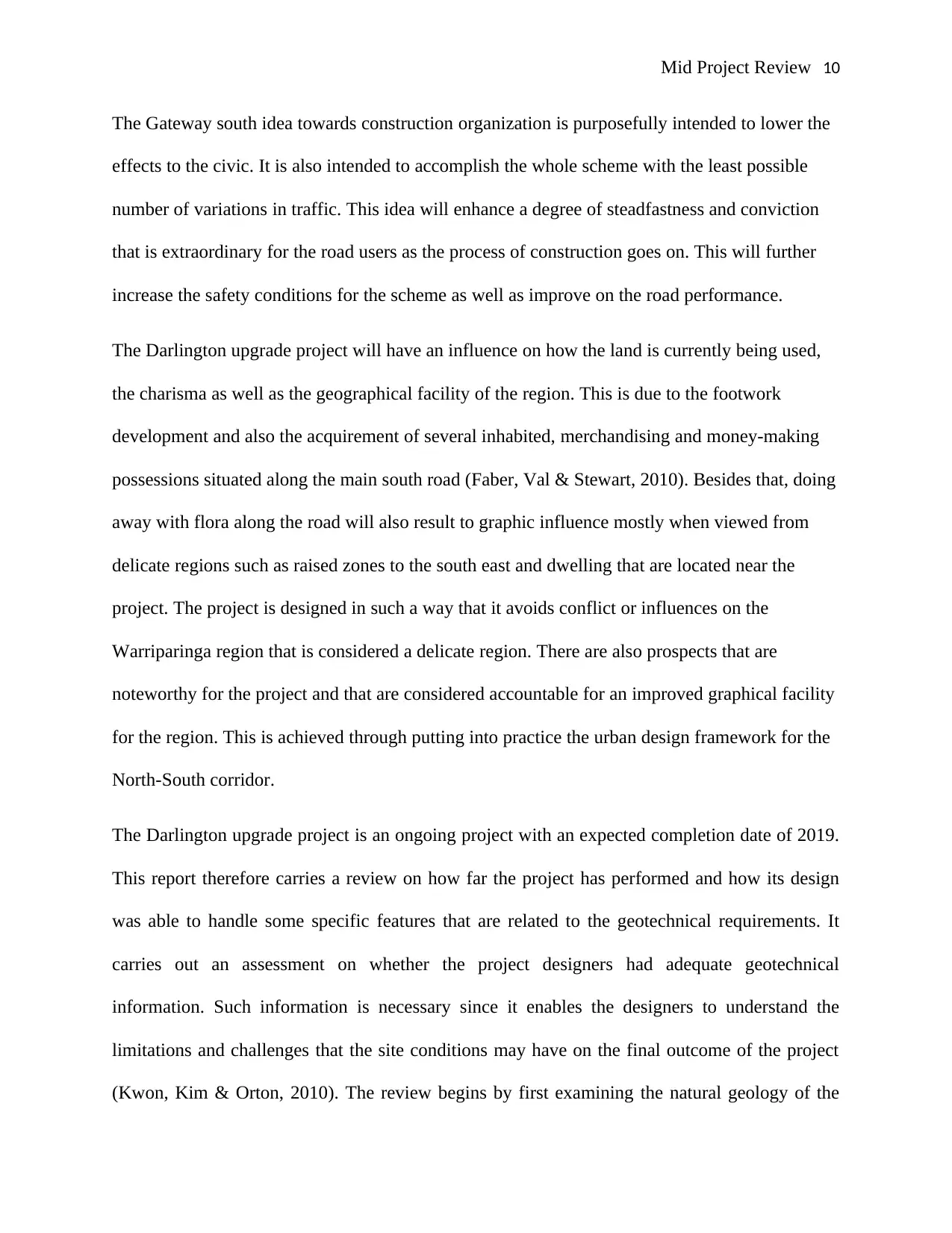
Mid Project Review 10
The Gateway south idea towards construction organization is purposefully intended to lower the
effects to the civic. It is also intended to accomplish the whole scheme with the least possible
number of variations in traffic. This idea will enhance a degree of steadfastness and conviction
that is extraordinary for the road users as the process of construction goes on. This will further
increase the safety conditions for the scheme as well as improve on the road performance.
The Darlington upgrade project will have an influence on how the land is currently being used,
the charisma as well as the geographical facility of the region. This is due to the footwork
development and also the acquirement of several inhabited, merchandising and money-making
possessions situated along the main south road (Faber, Val & Stewart, 2010). Besides that, doing
away with flora along the road will also result to graphic influence mostly when viewed from
delicate regions such as raised zones to the south east and dwelling that are located near the
project. The project is designed in such a way that it avoids conflict or influences on the
Warriparinga region that is considered a delicate region. There are also prospects that are
noteworthy for the project and that are considered accountable for an improved graphical facility
for the region. This is achieved through putting into practice the urban design framework for the
North-South corridor.
The Darlington upgrade project is an ongoing project with an expected completion date of 2019.
This report therefore carries a review on how far the project has performed and how its design
was able to handle some specific features that are related to the geotechnical requirements. It
carries out an assessment on whether the project designers had adequate geotechnical
information. Such information is necessary since it enables the designers to understand the
limitations and challenges that the site conditions may have on the final outcome of the project
(Kwon, Kim & Orton, 2010). The review begins by first examining the natural geology of the
The Gateway south idea towards construction organization is purposefully intended to lower the
effects to the civic. It is also intended to accomplish the whole scheme with the least possible
number of variations in traffic. This idea will enhance a degree of steadfastness and conviction
that is extraordinary for the road users as the process of construction goes on. This will further
increase the safety conditions for the scheme as well as improve on the road performance.
The Darlington upgrade project will have an influence on how the land is currently being used,
the charisma as well as the geographical facility of the region. This is due to the footwork
development and also the acquirement of several inhabited, merchandising and money-making
possessions situated along the main south road (Faber, Val & Stewart, 2010). Besides that, doing
away with flora along the road will also result to graphic influence mostly when viewed from
delicate regions such as raised zones to the south east and dwelling that are located near the
project. The project is designed in such a way that it avoids conflict or influences on the
Warriparinga region that is considered a delicate region. There are also prospects that are
noteworthy for the project and that are considered accountable for an improved graphical facility
for the region. This is achieved through putting into practice the urban design framework for the
North-South corridor.
The Darlington upgrade project is an ongoing project with an expected completion date of 2019.
This report therefore carries a review on how far the project has performed and how its design
was able to handle some specific features that are related to the geotechnical requirements. It
carries out an assessment on whether the project designers had adequate geotechnical
information. Such information is necessary since it enables the designers to understand the
limitations and challenges that the site conditions may have on the final outcome of the project
(Kwon, Kim & Orton, 2010). The review begins by first examining the natural geology of the
Secure Best Marks with AI Grader
Need help grading? Try our AI Grader for instant feedback on your assignments.
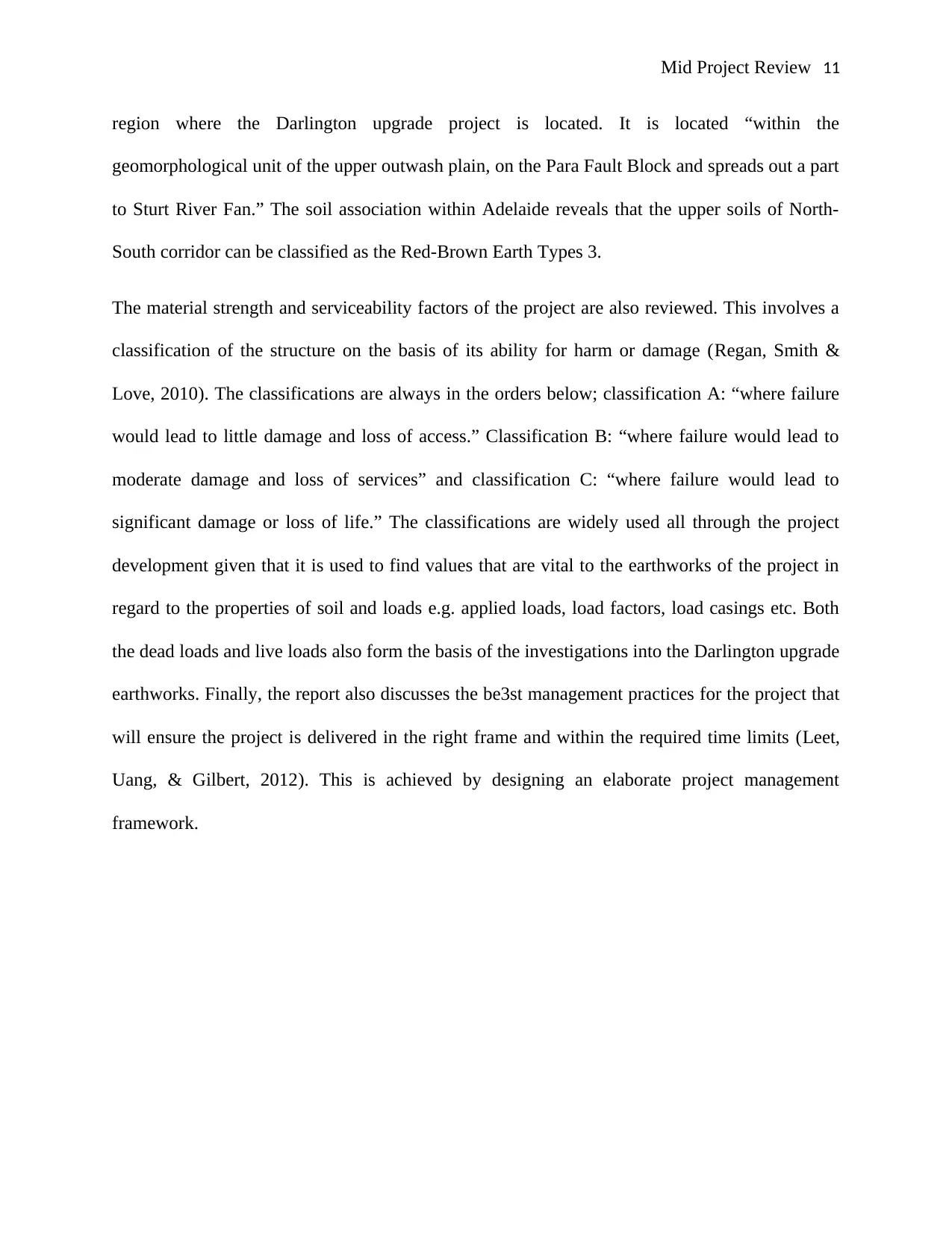
Mid Project Review 11
region where the Darlington upgrade project is located. It is located “within the
geomorphological unit of the upper outwash plain, on the Para Fault Block and spreads out a part
to Sturt River Fan.” The soil association within Adelaide reveals that the upper soils of North-
South corridor can be classified as the Red-Brown Earth Types 3.
The material strength and serviceability factors of the project are also reviewed. This involves a
classification of the structure on the basis of its ability for harm or damage (Regan, Smith &
Love, 2010). The classifications are always in the orders below; classification A: “where failure
would lead to little damage and loss of access.” Classification B: “where failure would lead to
moderate damage and loss of services” and classification C: “where failure would lead to
significant damage or loss of life.” The classifications are widely used all through the project
development given that it is used to find values that are vital to the earthworks of the project in
regard to the properties of soil and loads e.g. applied loads, load factors, load casings etc. Both
the dead loads and live loads also form the basis of the investigations into the Darlington upgrade
earthworks. Finally, the report also discusses the be3st management practices for the project that
will ensure the project is delivered in the right frame and within the required time limits (Leet,
Uang, & Gilbert, 2012). This is achieved by designing an elaborate project management
framework.
region where the Darlington upgrade project is located. It is located “within the
geomorphological unit of the upper outwash plain, on the Para Fault Block and spreads out a part
to Sturt River Fan.” The soil association within Adelaide reveals that the upper soils of North-
South corridor can be classified as the Red-Brown Earth Types 3.
The material strength and serviceability factors of the project are also reviewed. This involves a
classification of the structure on the basis of its ability for harm or damage (Regan, Smith &
Love, 2010). The classifications are always in the orders below; classification A: “where failure
would lead to little damage and loss of access.” Classification B: “where failure would lead to
moderate damage and loss of services” and classification C: “where failure would lead to
significant damage or loss of life.” The classifications are widely used all through the project
development given that it is used to find values that are vital to the earthworks of the project in
regard to the properties of soil and loads e.g. applied loads, load factors, load casings etc. Both
the dead loads and live loads also form the basis of the investigations into the Darlington upgrade
earthworks. Finally, the report also discusses the be3st management practices for the project that
will ensure the project is delivered in the right frame and within the required time limits (Leet,
Uang, & Gilbert, 2012). This is achieved by designing an elaborate project management
framework.
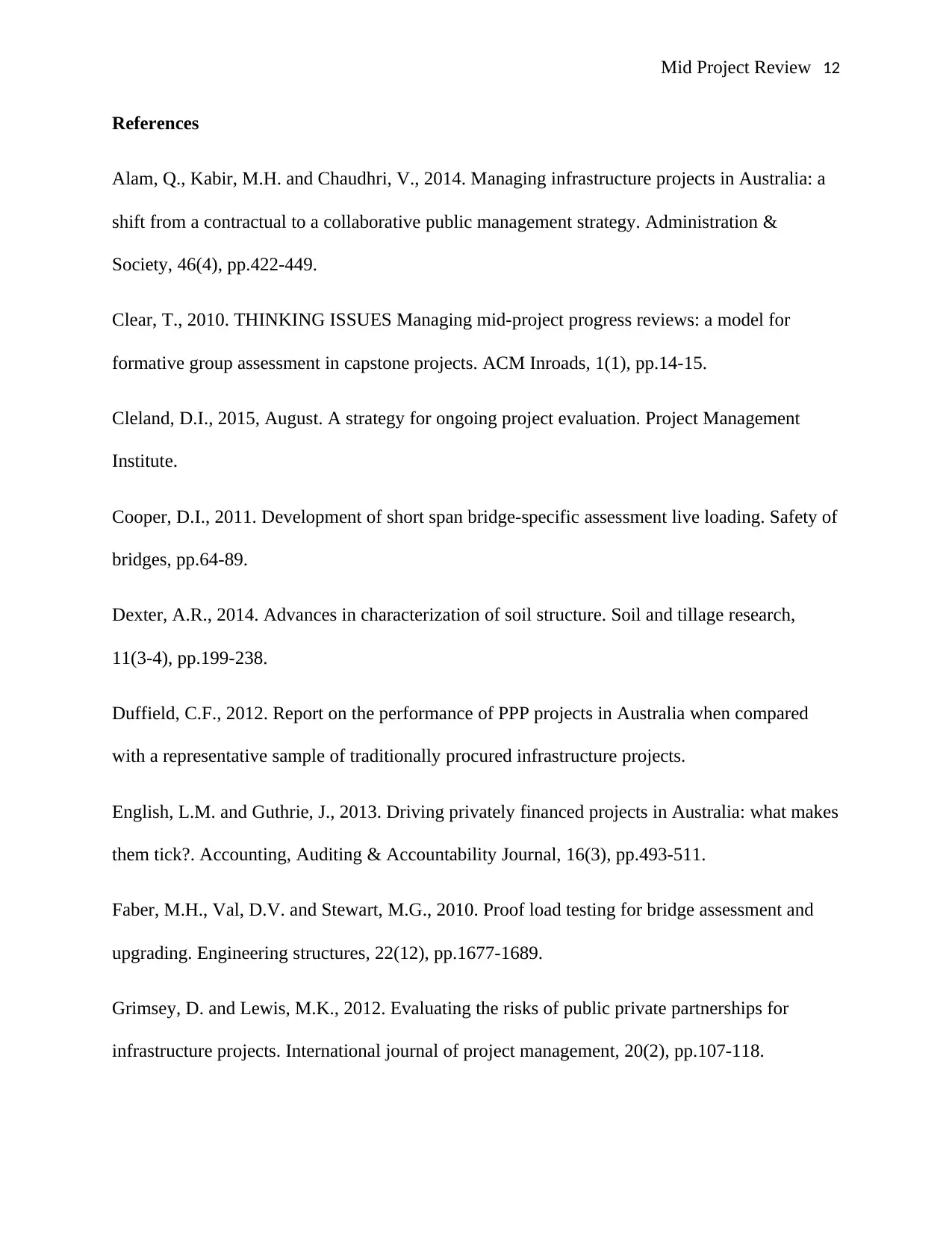
Mid Project Review 12
References
Alam, Q., Kabir, M.H. and Chaudhri, V., 2014. Managing infrastructure projects in Australia: a
shift from a contractual to a collaborative public management strategy. Administration &
Society, 46(4), pp.422-449.
Clear, T., 2010. THINKING ISSUES Managing mid-project progress reviews: a model for
formative group assessment in capstone projects. ACM Inroads, 1(1), pp.14-15.
Cleland, D.I., 2015, August. A strategy for ongoing project evaluation. Project Management
Institute.
Cooper, D.I., 2011. Development of short span bridge-specific assessment live loading. Safety of
bridges, pp.64-89.
Dexter, A.R., 2014. Advances in characterization of soil structure. Soil and tillage research,
11(3-4), pp.199-238.
Duffield, C.F., 2012. Report on the performance of PPP projects in Australia when compared
with a representative sample of traditionally procured infrastructure projects.
English, L.M. and Guthrie, J., 2013. Driving privately financed projects in Australia: what makes
them tick?. Accounting, Auditing & Accountability Journal, 16(3), pp.493-511.
Faber, M.H., Val, D.V. and Stewart, M.G., 2010. Proof load testing for bridge assessment and
upgrading. Engineering structures, 22(12), pp.1677-1689.
Grimsey, D. and Lewis, M.K., 2012. Evaluating the risks of public private partnerships for
infrastructure projects. International journal of project management, 20(2), pp.107-118.
References
Alam, Q., Kabir, M.H. and Chaudhri, V., 2014. Managing infrastructure projects in Australia: a
shift from a contractual to a collaborative public management strategy. Administration &
Society, 46(4), pp.422-449.
Clear, T., 2010. THINKING ISSUES Managing mid-project progress reviews: a model for
formative group assessment in capstone projects. ACM Inroads, 1(1), pp.14-15.
Cleland, D.I., 2015, August. A strategy for ongoing project evaluation. Project Management
Institute.
Cooper, D.I., 2011. Development of short span bridge-specific assessment live loading. Safety of
bridges, pp.64-89.
Dexter, A.R., 2014. Advances in characterization of soil structure. Soil and tillage research,
11(3-4), pp.199-238.
Duffield, C.F., 2012. Report on the performance of PPP projects in Australia when compared
with a representative sample of traditionally procured infrastructure projects.
English, L.M. and Guthrie, J., 2013. Driving privately financed projects in Australia: what makes
them tick?. Accounting, Auditing & Accountability Journal, 16(3), pp.493-511.
Faber, M.H., Val, D.V. and Stewart, M.G., 2010. Proof load testing for bridge assessment and
upgrading. Engineering structures, 22(12), pp.1677-1689.
Grimsey, D. and Lewis, M.K., 2012. Evaluating the risks of public private partnerships for
infrastructure projects. International journal of project management, 20(2), pp.107-118.
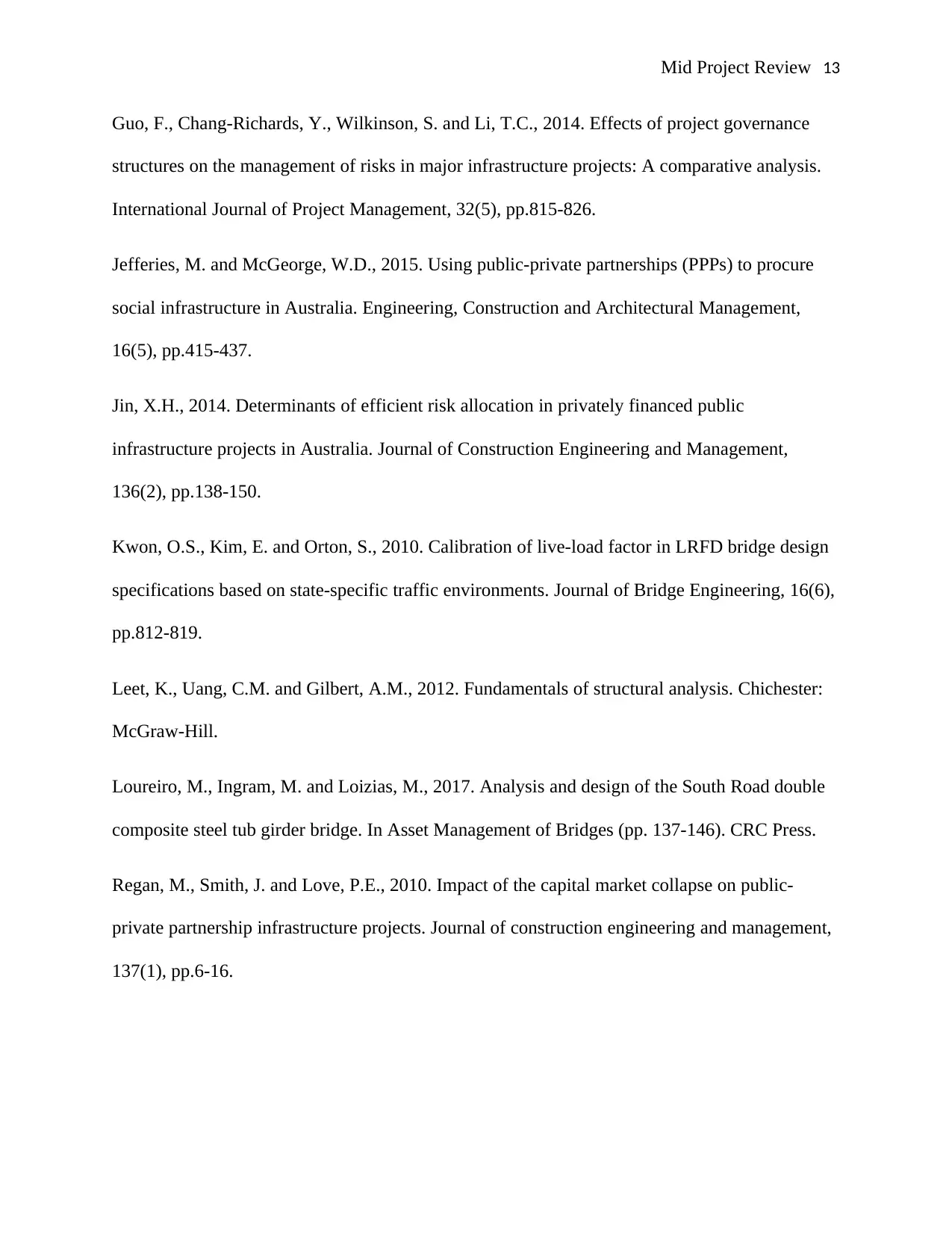
Mid Project Review 13
Guo, F., Chang-Richards, Y., Wilkinson, S. and Li, T.C., 2014. Effects of project governance
structures on the management of risks in major infrastructure projects: A comparative analysis.
International Journal of Project Management, 32(5), pp.815-826.
Jefferies, M. and McGeorge, W.D., 2015. Using public-private partnerships (PPPs) to procure
social infrastructure in Australia. Engineering, Construction and Architectural Management,
16(5), pp.415-437.
Jin, X.H., 2014. Determinants of efficient risk allocation in privately financed public
infrastructure projects in Australia. Journal of Construction Engineering and Management,
136(2), pp.138-150.
Kwon, O.S., Kim, E. and Orton, S., 2010. Calibration of live-load factor in LRFD bridge design
specifications based on state-specific traffic environments. Journal of Bridge Engineering, 16(6),
pp.812-819.
Leet, K., Uang, C.M. and Gilbert, A.M., 2012. Fundamentals of structural analysis. Chichester:
McGraw-Hill.
Loureiro, M., Ingram, M. and Loizias, M., 2017. Analysis and design of the South Road double
composite steel tub girder bridge. In Asset Management of Bridges (pp. 137-146). CRC Press.
Regan, M., Smith, J. and Love, P.E., 2010. Impact of the capital market collapse on public-
private partnership infrastructure projects. Journal of construction engineering and management,
137(1), pp.6-16.
Guo, F., Chang-Richards, Y., Wilkinson, S. and Li, T.C., 2014. Effects of project governance
structures on the management of risks in major infrastructure projects: A comparative analysis.
International Journal of Project Management, 32(5), pp.815-826.
Jefferies, M. and McGeorge, W.D., 2015. Using public-private partnerships (PPPs) to procure
social infrastructure in Australia. Engineering, Construction and Architectural Management,
16(5), pp.415-437.
Jin, X.H., 2014. Determinants of efficient risk allocation in privately financed public
infrastructure projects in Australia. Journal of Construction Engineering and Management,
136(2), pp.138-150.
Kwon, O.S., Kim, E. and Orton, S., 2010. Calibration of live-load factor in LRFD bridge design
specifications based on state-specific traffic environments. Journal of Bridge Engineering, 16(6),
pp.812-819.
Leet, K., Uang, C.M. and Gilbert, A.M., 2012. Fundamentals of structural analysis. Chichester:
McGraw-Hill.
Loureiro, M., Ingram, M. and Loizias, M., 2017. Analysis and design of the South Road double
composite steel tub girder bridge. In Asset Management of Bridges (pp. 137-146). CRC Press.
Regan, M., Smith, J. and Love, P.E., 2010. Impact of the capital market collapse on public-
private partnership infrastructure projects. Journal of construction engineering and management,
137(1), pp.6-16.
Paraphrase This Document
Need a fresh take? Get an instant paraphrase of this document with our AI Paraphraser
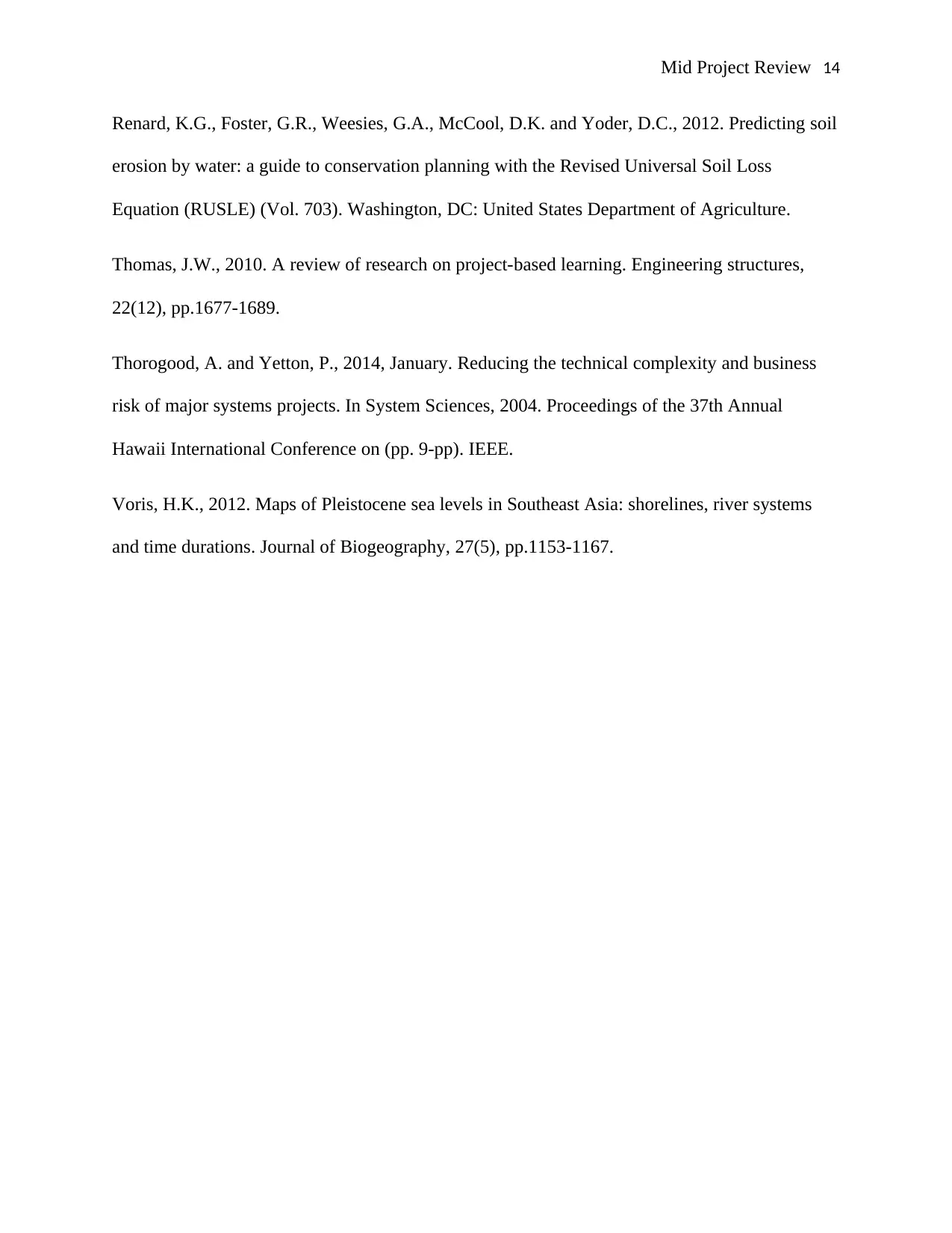
Mid Project Review 14
Renard, K.G., Foster, G.R., Weesies, G.A., McCool, D.K. and Yoder, D.C., 2012. Predicting soil
erosion by water: a guide to conservation planning with the Revised Universal Soil Loss
Equation (RUSLE) (Vol. 703). Washington, DC: United States Department of Agriculture.
Thomas, J.W., 2010. A review of research on project-based learning. Engineering structures,
22(12), pp.1677-1689.
Thorogood, A. and Yetton, P., 2014, January. Reducing the technical complexity and business
risk of major systems projects. In System Sciences, 2004. Proceedings of the 37th Annual
Hawaii International Conference on (pp. 9-pp). IEEE.
Voris, H.K., 2012. Maps of Pleistocene sea levels in Southeast Asia: shorelines, river systems
and time durations. Journal of Biogeography, 27(5), pp.1153-1167.
Renard, K.G., Foster, G.R., Weesies, G.A., McCool, D.K. and Yoder, D.C., 2012. Predicting soil
erosion by water: a guide to conservation planning with the Revised Universal Soil Loss
Equation (RUSLE) (Vol. 703). Washington, DC: United States Department of Agriculture.
Thomas, J.W., 2010. A review of research on project-based learning. Engineering structures,
22(12), pp.1677-1689.
Thorogood, A. and Yetton, P., 2014, January. Reducing the technical complexity and business
risk of major systems projects. In System Sciences, 2004. Proceedings of the 37th Annual
Hawaii International Conference on (pp. 9-pp). IEEE.
Voris, H.K., 2012. Maps of Pleistocene sea levels in Southeast Asia: shorelines, river systems
and time durations. Journal of Biogeography, 27(5), pp.1153-1167.
1 out of 14
Related Documents
Your All-in-One AI-Powered Toolkit for Academic Success.
+13062052269
info@desklib.com
Available 24*7 on WhatsApp / Email
![[object Object]](/_next/static/media/star-bottom.7253800d.svg)
Unlock your academic potential
© 2024 | Zucol Services PVT LTD | All rights reserved.





